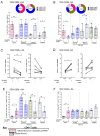Retinoic Acid Improves the Recovery of Replication-Competent Virus from Latent SIV Infected Cells
- PMID: 32932813
- PMCID: PMC7565696
- DOI: 10.3390/cells9092076
Retinoic Acid Improves the Recovery of Replication-Competent Virus from Latent SIV Infected Cells
Abstract
The accurate estimation and eradication of Human Immunodeficiency Virus (HIV) viral reservoirs is limited by the incomplete reactivation of cells harboring the latent replication-competent virus. We investigated whether the in vitro and in vivo addition of retinoic acid (RA) enhances virus replication and improves the detection of latent virus. Peripheral blood mononuclear cells (PBMCs) from naive and anti-retroviral therapy (ART)-treated SIV-infected rhesus macaques (RMs) were cultured in vitro with anti-CD3/CD28 + IL-2 in the presence/absence of RA. Viral RNA and p27 levels were quantified using RT-qPCR and ELISA, respectively. Viral reservoirs were estimated using the Tat/Rev-Induced Limited Dilution Assay (TILDA) and Quantitative Viral Outgrowth Assay (QVOA). In vitro and in vivo measures revealed that there was also an increase in viral replication in RA-treated versus without RA conditions. In parallel, the addition of RA to either CD3/CD28 or phorbol myristate acetate (PMA)/ionomycin during QVOA and TILDA, respectively, was shown to augment reactivation of the replication-competent viral reservoir in anti-retroviral therapy (ART)-suppressed RMs as shown by a greater than 2.3-fold increase for QVOA and 1 to 2-fold increments for multi-spliced RNA per million CD4+ T cells. The use of RA can be a useful approach to enhance the efficiency of current protocols used for in vitro and potentially in vivo estimates of CD4+ T cell latent reservoirs. In addition, flow cytometry analysis revealed that RA improved estimates of various viral reservoir assays by eliciting broad CD4 T-cell activation as demonstrated by elevated CD25 and CD38 but reduced CD69 and PD-1 expressing cells.
Keywords: CD3/CD28 treatment; CD4 T cells; PBMCs; SIV; immune activation; retinoic acid; viral load and provirus.
Conflict of interest statement
The authors declare no conflict of interest.
Figures




Similar articles
-
Brain Macrophages in Simian Immunodeficiency Virus-Infected, Antiretroviral-Suppressed Macaques: a Functional Latent Reservoir.mBio. 2017 Aug 15;8(4):e01186-17. doi: 10.1128/mBio.01186-17. mBio. 2017. PMID: 28811349 Free PMC article.
-
Short-Term Pegylated Interferon α2a Treatment Does Not Significantly Reduce the Viral Reservoir of Simian Immunodeficiency Virus-Infected, Antiretroviral Therapy-Treated Rhesus Macaques.J Virol. 2018 Jun 29;92(14):e00279-18. doi: 10.1128/JVI.00279-18. Print 2018 Jul 15. J Virol. 2018. PMID: 29720521 Free PMC article.
-
Myeloid and CD4 T Cells Comprise the Latent Reservoir in Antiretroviral Therapy-Suppressed SIVmac251-Infected Macaques.mBio. 2019 Aug 20;10(4):e01659-19. doi: 10.1128/mBio.01659-19. mBio. 2019. PMID: 31431552 Free PMC article.
-
Brain macrophages harbor latent, infectious simian immunodeficiency virus.AIDS. 2019 Dec 1;33 Suppl 2(Suppl 2):S181-S188. doi: 10.1097/QAD.0000000000002269. AIDS. 2019. PMID: 31789817 Free PMC article. Review.
-
An SIV/macaque model targeted to study HIV-associated neurocognitive disorders.J Neurovirol. 2018 Apr;24(2):204-212. doi: 10.1007/s13365-017-0582-4. Epub 2017 Oct 3. J Neurovirol. 2018. PMID: 28975505 Free PMC article. Review.
Cited by
-
Diminished Peripheral CD29hi Cytotoxic CD4+ T Cells Are Associated With Deleterious Effects During SIV Infection.Front Immunol. 2021 Oct 13;12:734871. doi: 10.3389/fimmu.2021.734871. eCollection 2021. Front Immunol. 2021. PMID: 34721397 Free PMC article.
-
Fgfr2b signaling is essential for the maintenance of the alveolar epithelial type 2 lineage during lung homeostasis in mice.Cell Mol Life Sci. 2022 May 19;79(6):302. doi: 10.1007/s00018-022-04327-w. Cell Mol Life Sci. 2022. PMID: 35587837 Free PMC article.
-
Chronic morphine administration differentially modulates viral reservoirs in SIVmac251 infected rhesus macaque model.J Virol. 2021 Mar 1;95(5):e01657-20. doi: 10.1128/JVI.01657-20. Epub 2020 Dec 16. J Virol. 2021. PMID: 33328304 Free PMC article.
-
Actions of Retinoic Acid in the Pathophysiology of HIV Infection.Nutrients. 2022 Apr 12;14(8):1611. doi: 10.3390/nu14081611. Nutrients. 2022. PMID: 35458172 Free PMC article. Review.
-
Dual role for microbial short-chain fatty acids in modifying SIV disease trajectory following anti-α4β7 antibody administration.Ann Med. 2024 Dec;56(1):2315224. doi: 10.1080/07853890.2024.2315224. Epub 2024 Feb 14. Ann Med. 2024. PMID: 38353210 Free PMC article.
References
-
- Cohen C. Second ‘Cured’ HIV Patient Goes Public. [(accessed on 25 June 2020)]; Available online: https://www.sciencemag.org/news/2020/03/second-cured-hiv-patient-goes-pu....
-
- Henrich T.J., Hanhauser E., Marty F.M., Sirignano M.N., Keating S., Lee T.H., Robles Y.P., Davis B.T., Li J.Z., Heisey A., et al. Antiretroviral-free HIV-1 remission and viral rebound after allogeneic stem cell transplantation: Report of 2 cases. Ann. Intern. Med. 2014;161:319–327. doi: 10.7326/M14-1027. - DOI - PMC - PubMed
Publication types
MeSH terms
Substances
Grants and funding
LinkOut - more resources
Full Text Sources
Research Materials

